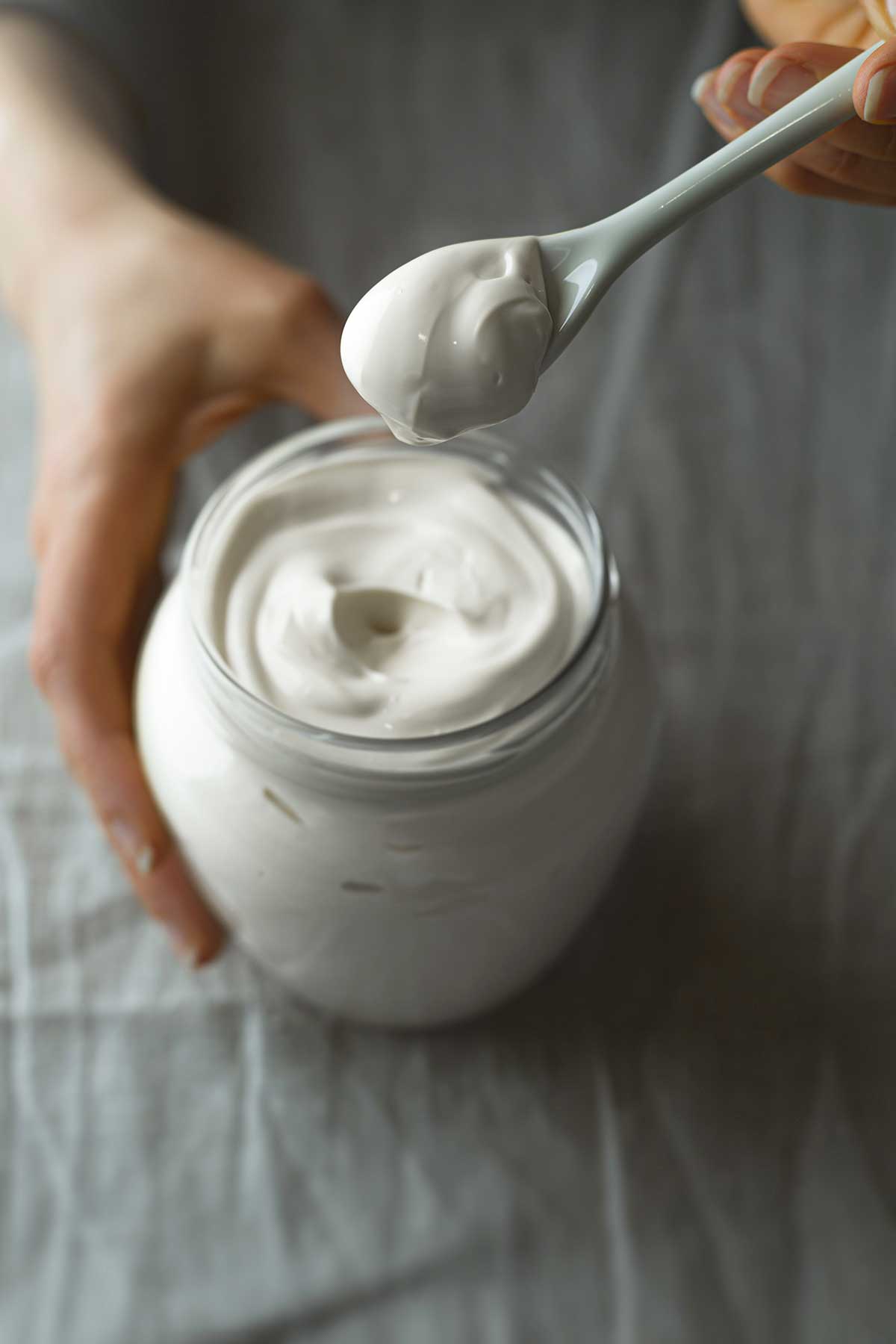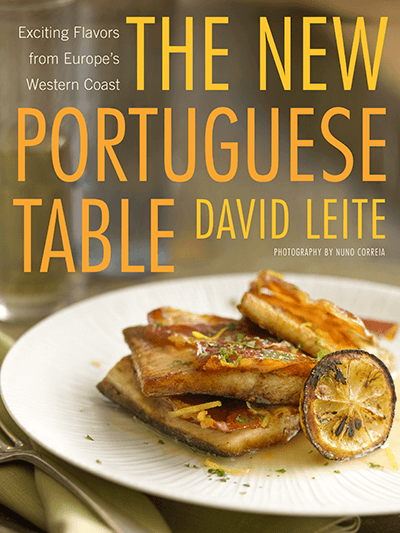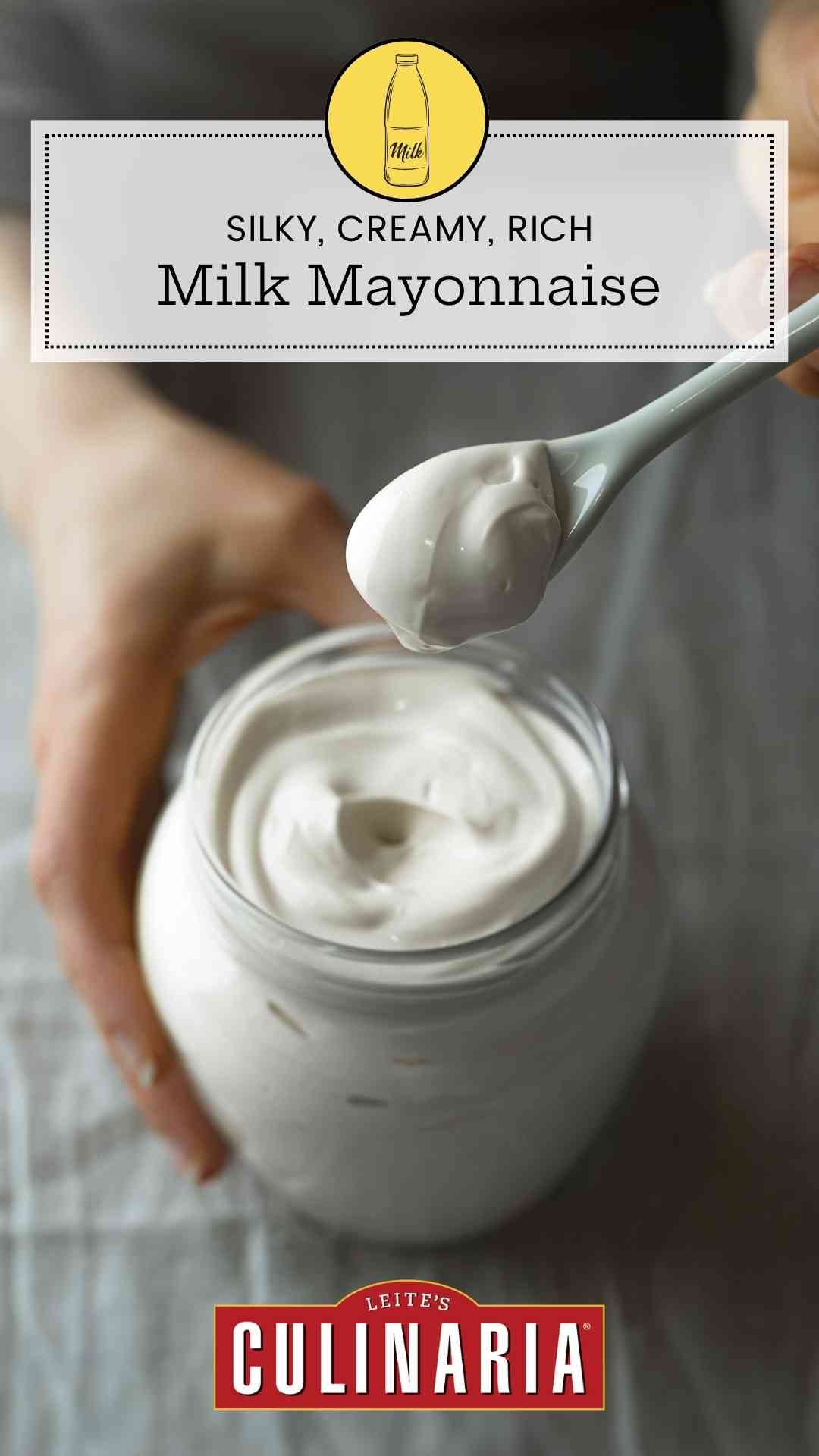
This is one of those recipes that require quotation marks, not out of affectation, but because it’s not a true mayonnaise. It contains no egg yolks or mustard. It’s nothing more than an emulsion of milk and oil. More Brazilian than Portuguese, it’s just now beginning to be used on the Continent. The taste is lighter and cleaner than that of egg-based mayonnaise, allowing other flavors to come through.
☞ Read the Article: The Secret Behind Milk Mayonnaise
Since I was given the recipe, I haven’t stopped finding ways to cook with it. The master recipe is only a canvas for additions. Besides the uses in this book, I’ve smeared the variations on grilled meats and fish, used them as dips and in dressings, spread them on sandwiches, and stirred them into potato salads, much as I do with actual mayonnaise.
Why Isn’t my Mayonnaise Emulsifying?
Like all emulsions, this recipe can be a bit finicky. But adding the oil in a thin stream and stopping when the right consistency is reached is the key. For almost foolproof results, a handheld blender is best, but a small canister blender with a narrow base will do (tall and narrow is best here). Don’t do as some of us did and assume that a stand mixer or food processor will work—it just won’t. If you’re working with a less-than-powerful immersion blender, the consistency of the mayonnaise may turn out thinner than you’d expect. You can help it along by slowly adding 2 more tablespoons of oil to the milk mayonnaise as you continue to blend and it will thicken nicely.

Milk Mayonnaise
Ingredients
- ⅓ cup very cold milk
- ¾ teaspoon fresh lemon juice
- 1 small garlic clove, peeled
- ⅛ teaspoon white pepper
- About ¾ cup vegetable oil, or 1/2 cup (118 ml) vegetable oil plus 1/4 cup (60 ml) olive oil
- Kosher salt
Instructions
- Combine the milk, lemon juice, garlic, and pepper in a 2-cup glass measuring cup. Using a handheld blender (or a blender), buzz on high for 30 seconds until frothy.
- With the motor running on high, slowly pour in the oil a few drops at a time, and gradually increase this to a fine thread, moving the blender up and down, until the mixture thickens lusciously and resembles a soft mayonnaise. You may need more or less oil.
- Season with salt to taste. The mayonnaise will last up to 1 week in the fridge.
Notes
Milk mayonnaise variations
Clockwise from top right: cilantro-ginger, curry, anchovy, sun-dried tomato.
Cilantro and Ginger Milk Mayonnaise | Maionese de Leite com Coentros e Gengibre
Add 1 loosely packed cup of well-dried fresh cilantro leaves and tendril-soft stems and a 1 1/2-inch peeled and grated thumb of ginger to the cup along with the milk, 1 3/4 teaspoons of lemon juice, and the pepper. Omit the garlic. Whir in the oil as directed above. Stir in 1 scallion cut into thin slices on the diagonal.Anchovy Milk Mayonnaise | Maionese de Leite com Anchovas
Add 6 anchovy fillets (generous 1 tablespoon) packed in oil to the cup along with the milk, lemon juice, garlic, and pepper. Whir in the oil as directed above. Omit the salt.Curry Milk Mayonnaise | Maionese de Leite com Caril
Add 2 teaspoons of your favorite curry powder to the cup along with the milk, lemon juice, garlic, and pepper. Whir in the oil as directed above. Before using, let this sit for an hour or so in the fridge to bloom.Tomato Milk Mayonnaise | Maionese de Leite com Tomate
Add 1 1/2 tablespoons of double-concentrate tomato paste to the cup along with the milk, garlic, and pepper. Omit the lemon juice. Whir in the oil as directed above. Stir in 1 tablespoon minced oil-packed sun-dried tomatoes.
Explore More with AI
Nutrition
Nutrition information is automatically calculated, so should only be used as an approximation.











David, I have spent the last few hours reading comments, after reading your blog. Hopefully this hasn’t been asked, since I didn’t notice it, but curious why this mayo recipe suggests cold milk when all the mayo recipes I’ve read insist all ingredients be room temperature. I’ve had some flops, some successes, and realize now I need an immersion blender, which I just ordered. Haven’t tried yours yet till it comes, but very curious about the cold milk thing. The other recipes were mostly egg or egg white mayos.
Susan, traditional mayos call for eggs and for them to be room temperature. This isn’t actually a mayonnaise, but a milk emulsion. The reason for cold milk is it seems to hold the emulsion better than room temperature milk.
OMG! the mayo came out so goooood! I’ve tried making it before with another recipe and it was just watery so I was a bit apprehensive this time around. But I’m so so pleased!
Delighted you like it so much, priyal! This recipe is considered by most to be the “original,” meaning it was the first time it had been translated and tested for U.S. cooks. I’ve seen many, many adaptations that simply don’t work!
I’m vegan so I’m going to try this using coconut milk and refined coconut oil. I’m wondering if I should use coconut oil that is liquid or semi solid?
Judy, I’ve never tried it that way, so I can’t say with surety. But I’d be curious as to your results!
I’ll let you know! If anyone has used coconut oil in this recipe, feel free to pipe up 🙂
Hi David,
I just realized I never got back to you on this! I did create a Mock Mayo recipe and published it in my cookbook. It’s a big hit! If you’re interested, I could send it to you with a photo to be included in your recipes.
Judy
Judy, superb! I’m glad it worked for you. And congrats on the book!
Thank you!
You’re more than welcome, Judy.